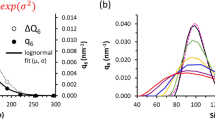Summary
Analysis of 5 to 6 d primary cultures of cells derived from murine thymus glands revealed a heterogeneous population of cells rather than “pure” reticuloepithelial cell cultures as was assumed previously by other investigators. The monolayer cultures consisted of at least three cell types: thymus epithelial cells, macrophagelike epithelioid cells, and fibroblasts. Surprisingly, about 50% of the cells had positive cytochemical staining reactions for acid phosphatase and nonspecific esterase. The same cells phagocytized carbon particles, latex beads, and yeast. Furthermore, these cells could be removed from the initial cell suspension by phagocytosis of carbonyl iron, followed by magnetic separation, but once they had adhered to the substratum they were resistant to trypsin removal. All of these findings supported the conclusion that about 50% of the cells in the monolayers were macrophages. The other cells present were thymus epithelial cells and a small number of fibroblasts. Both of the latter types of cell were cytochemically negative, did not phagocytize particulate material, and were not removed by carbonyl iron treatment, but were removed by treating the monolayer with trypsin. The findings in this report indicated that epithelioid morphology alone was inadequate to identify correctly the cell types found in thymus cultures and that the use of such cultures as a model to study in vitro the maturation of certain immunological functions has been based on assumptions here shown to be incorrect.
Similar content being viewed by others
References
Owen, J. J. T. Ontogenesis of lymphocytes. Loor, F.; Roelants, G. E. eds. B and T cells in immune recognition. Chichester, England: J. Wiley and Sons; 1977: 21–34.
Zinkernagel, R. M.; Callahan, G. N.; Althage, A.; Cooper, S.; Klein, P. A.; Klein, J., On the thymus in the differentiation of “H-2 self-recognition” by cells: evidence for dual recognition? J. Exp. Med. 147: 882–896; 1978.
Stutman, O.; Yunis, E. J.; Good, R. A. Studies on thymus function. I. Cooperative effect of thymic function and lymphohemopoietic cells in restoration of neonatally thymectomized mice. J. Exp. Med. 132: 583–599; 1970.
Rouse, R. V.; vanEwijk, W.; Jones, P. P.; Weissman, I. L. Expression of MHC antigens by mouse thymic dendritic cells. J. Immunol. 122: 2508–2515; 1979.
Clark, S. L., Jr. Incorporation of sulfate by the mouse thymus: Its relation to secretion by medullary epithelial cells and to thymic lymphopoiesis. J. Exp. Med. 128: 927–957; 1968.
Stutman, O.; Yunis, E. J.; Good, R. A. Studies on thymus function. III. Duration of thymic function. J. Exp. Med. 135: 339–356; 1972.
Mosier, D.; Pierce, C. W. Functional maturation of thymic lymphocyte populations in vitro. J. Exp. Med. 136: 1484–1500; 1972.
Wekerle, H.; Cohen, I. R.; Feldman, M., Thymus reticulum cell cultures confer T cell properties on spleen cells from thymus-deprived animals. Eur. J. Immunol. 3: 745–748; 1973.
Papiernik, M.; Nabarra, B.; Bach, J. F. In vitro culture of functional human thymic epithelium. Clin. Exp. Immunol. 19: 281–287; 1975.
Willis-Carr, J. I. Ochs, H. D.; Wedgwood, R. J. Induction of T lymphocyte differentiation by thymic epithelial cell monolayers. Clin. Immunol. Immunopathol. 10: 315–324; 1978.
Waksal, S. D.; Cohen, I. R.; Waksal H. W.; Wekerle, H.; St. Pierre, R. L.; Feldman, M. Induction of T-cell differentiation in vitro by thymus epithelial cells. Ann. NY Acad. Sci. 249: 492–498; 1975.
Beller, D. I.; Unanue, E. R. Thymic maturation in vitro by a secondary product from macrophages. J. Immunol. 118: 1780–1787; 1977.
Beller, D. I.; Unanue, E. R. Thymic macrophages modulate one stage of T cell differentiation in vitro. J. Immunol. 121: 1861–1864; 1978.
Burry, R. W.; Lasher, R. S. A quantitative electron microscopic study of synapse formation in dispersed cell cultures of rat cerebellum stained either by Os-UL or by E-PTA. Brain Res. 147: 1–15; 1978.
Davis, B. J.; Ornstein, L. High resolution enzyme localization with a new diazo reagent, “hexazonium pararosaliline” J. Histochem. Cytochem. 7: 297–298; 1959.
Barka, T. A simple azo-dye method for histochemical demonstration of acid phosphatase. Nature 187: 248–249; 1960.
Cohn, Z. A.; Wiener, E. The particulate hydrolases of macrophages. I. Comparative enzymology, isolation, and properties. J. Exp. Med. 118: 991–1023; 1963.
Smith, C., Studies on the thymus of the mammal. XIV. Histology and histochemistry of embryonic and early postnatal thymuses of C57B1/6 and AKR strain mice. Am. J. Anat. 116: 611–630; 1965.
Clark, S. L., Jr. The thymus in mice of strain 129/J, studied with the electron microscope. Am. J. Anat. 112: 1–57; 1963.
Kostowiecki, M. The thymic macrophages. Z. F. Mikr. Anat. Forschung. 69: 585–614; 1963.
Paul, J. Cell and tissue culture. 5th ed. Edinburgh: Churchill Livingstone; 1975: 331–333.
Sutton, J. S.; Weiss, L. Transformation of monocytes in tissue culture into macrophages, epithelioid cells, and multinucleated giant cells. J. Cell Biol. 28: 303–331; 1966.
Jordan, R. K.; Crouse, D. A. Studies on the thymic microenvironment: Morphologic and functional characterization of thymic nonlymphoid cells grown in tissue culture. J. Reticuloendothel. Soc. 26: 385–399; 1979.
Berridge, M. V.; Nargang, J. C. Loverde, P. T.; Golub, E. S. The culture of mouse thymic reticulum cells: The effect of homologous serum on the establishment of primary cultures. J. Immunol. 124: 2738–2746; 1980.
Loor, F. Mouse thymus reticuloepithelial (RE) cells in vitro: Isolation cultivation and preliminary characterization. Immunology 37: 157–177; 1979.
Kruisbeek, A. M. Thymic factors and T cell maturation in vitro: A comparison of the effects of thymic epithelial cultures with thymic extracts and thymus dependent serum factors. Thymus 1: 163–185; 1979.
Jenkinson, E. J.; Owen, J. J. T.; Aspinall, R. Lymphocyte differentiation and major histocompatibility complex and antigen expression in the embryonic thymus. Nature 284: 177–179; 1980.
Author information
Authors and Affiliations
Additional information
This work was supported by the Graduate School, The Ohio State University, the Bremer Foundation, the American Cancer Society (IN-16R), and National Cancer Institute Grant 5 ROL CA-19346-03.
Rights and permissions
About this article
Cite this article
Jones, K.H., Pierre, R.L.S. Analysis of cellular heterogeneity in mouse thymus cultures. In Vitro 17, 431–440 (1981). https://doi.org/10.1007/BF02626744
Received:
Accepted:
Issue Date:
DOI: https://doi.org/10.1007/BF02626744




